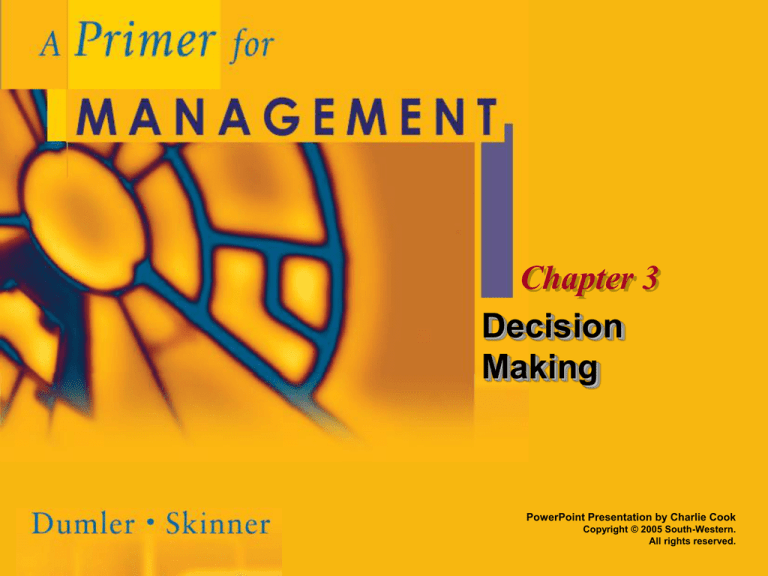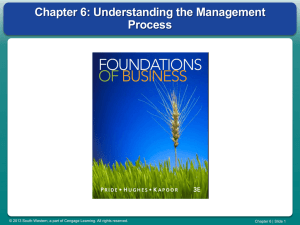
Chapter 3
Decision
Making
PowerPoint Presentation by Charlie Cook
Copyright © 2005 South-Western.
All rights reserved.
Decisions
• Decision defined
A choice among competing alternatives and the
implementation of the chosen alternative; all
decisions have a time horizon or scope.
• Strategic decisions
Have a long-term perspective; they are related to an
organization’s overall strategy.
• Tactical decisions
Have a shorter time scope; entail choices that must
be made in the near term.
Must be consistent with the organization’s strategy.
Copyright © 2005 South-Western. All rights reserved.
3–2
Conditions Affecting Decisions
• Certainty
The decision maker has complete information of the
probabilities of the outcomes of each alternative.
• Uncertainty
The decision maker has absolutely no knowledge of
the probabilities of the outcomes of each alternative.
• Risk
The decision maker has some probabilistic estimate
of the outcomes of each alternative.
Copyright © 2005 South-Western. All rights reserved.
3–3
The Decision Making Process
• Decision making process defined
A series of related steps or stages (a choice among alternative
courses of action) leading to an action, an outcome, and
assessment.
• Managerial decision making
From managerial perspective, a decision is an action that
someone takes and is subsequently accountable for.
Managerial decision-making process
Is often fragmented and rapid, responding to interruptions
and unexpected events.
Involves reason and emotion, risk and uncertainty, and
imagination and knowledge.
Copyright © 2005 South-Western. All rights reserved.
3–4
Types of Managerial Decisions
• Programmed decision
If a particular situation occurs often, a solution is
designed in the form of a routine procedure.
• Non-programmed decision
Decisions are unstructured, novel, or unique one-time
situations that require a choice among existing
alternatives.
There is no established procedure for handling the
problem.
Copyright © 2005 South-Western. All rights reserved.
3–5
Types of Managerial Decisions (cont’d)
• Proactive decision
A decision made in anticipation of an external change
or other conditions.
Rational, proactive approach can prevent problems
from developing.
• Reactive decision
An after-the-fact decision made in response to
external changes.
Suggests a lack of planning and strategy.
Copyright © 2005 South-Western. All rights reserved.
3–6
Types of Managerial Decisions (cont’d)
• Intuitive decisions
Involve the use of estimates, guesses, or hunches to
decide among alternative courses of action.
• Systematic decisions
Result from a logical, organized analytic process.
Systematic decision-making requires
A clear
set of objectives.
A relevant information base.
Rational and creative generation, implementation, and
assessment of alternatives.
Copyright © 2005 South-Western. All rights reserved.
3–7
Types of Managerial Decisions (cont’d)
• Mintzberg’s strategic decision categories
Entrepreneurial decisions—inventive decisions that
strategic managers make about the nature of the
product and the future of the organization.
Adaptive decisions—reactive responses to
environmental conditions.
Planning decisions—proactive as well as reactive
decisions that develop specific reactions to reduce
uncertainties related to growth, uniqueness, and
efficiency.
Copyright © 2005 South-Western. All rights reserved.
3–8
Decision Models
• Rational decision model
A prescriptive model
Advises
the decision maker how decisions should be
made.
Bases a decision on a logical, factual analysis that
leads the decision maker to an optimal decision.
Rational decision model assumes:
People
attempt to make logical decisions.
The alternative chosen offers the greatest benefits.
There is little uncertainty and risk in the decision.
Decision makers rely on rules and procedures to reach
a decision.
Copyright © 2005 South-Western. All rights reserved.
3–9
Decision Models (cont’d)
• Rational decision model (cont’d)
Most appropriate for:
Programmed
decisions.
Situations where all the alternatives are known.
Unambiguous decisions.
Situations where information is readily available.
Individual decision making.
Copyright © 2005 South-Western. All rights reserved.
3–10
Decision Models (cont’d)
• Administrative decision model
A descriptive model
Makes
more realistic assumptions about the decision
context and human nature.
Describes how people actually make decisions, not how
they should make them.
Administrative decision model assumes:
Limited
information processing ability.
Non-programmed decisions.
Preferences of individuals or group.
Alternatives are unclear.
Greater participation through group decision making.
Copyright © 2005 South-Western. All rights reserved.
3–11
Decision Models (cont’d)
• Administrative decision model (cont’d)
Satisficing
To
seek a satisfactory decision, one that’s good enough
but not perfect.
The first alternative that proves to be a satisfactory
alternative (solution) is the one chosen.
Copyright © 2005 South-Western. All rights reserved.
3–12
Decision Models (cont’d)
Movie Decision Model Matrix
Exhibit 3 . 1
Copyright © 2005 South-Western. All rights reserved.
3–13
Decision Models (cont’d)
• Political decision model
Political decisions are:
Non-programmed
decisions ruled by political concerns
rather than a logical analysis of the situation.
Not the best decision, but the alternative (decision) that
will be accepted by the groups involved in the decision.
More political the more diverse are the participants in
the decision-making process.
Copyright © 2005 South-Western. All rights reserved.
3–14
Political Decision Model (cont’d)
• Political decision model (cont’d)
Characteristics of political decisions:
Are
non-programmed.
Contain ambiguous information.
Entail low consensus on goals among stakeholders.
Involve groups that can influence the decision process.
Copyright © 2005 South-Western. All rights reserved.
3–15
Decision Models (cont’d)
Decision-Making Models
Rational
Administrative
Political
Decision Type
Programmed
Non-programmed
Non-programmed
Decision Outcome
Optimal
Satisficed
Negotiated
Degree of Objectivity
High
Moderate
Moderate to low
Exhibit 3 . 2
Copyright © 2005 South-Western. All rights reserved.
3–16
The Decision-Making Process
• Step 1: Identify and define the problem
Problem: realization that a discrepancy exists
between a desired state and current reality.
Problem identification factors:
Perceptual
inaccuracies.
Defining problems in terms of solutions.
Identifying symptoms as problems.
Copyright © 2005 South-Western. All rights reserved.
3–17
The Decision-Making Process (cont’d)
• Step 2: Establish decision criteria
Determine significance of each problem according to:
Urgency:
amount of time available to solve a problem.
Impact: seriousness of a problem’s effect.
Growth tendency: future consequences of a problem.
• Step 3: Weight criteria
Weighting: process of ranking importance of decision
criteria.
Copyright © 2005 South-Western. All rights reserved.
3–18
The Decision-Making Process (cont’d)
• Step 4: Develop alternatives
Examine organization’s internal and external
environment for solutions to problem.
• Step 5: Evaluate alternatives
Select alternatives that will produce most favorable
outcomes and least unfavorable outcomes.
• Step 6: Decide on a solution
Select a particular solution to achieve a
predetermined objective.
Copyright © 2005 South-Western. All rights reserved.
3–19
The Decision-Making Process (cont’d)
• Step 7: Implement the decision
Implementation may be more important than the
actual choice of alternative.
• Step 8: Feedback and evaluation
System of control and evaluation necessary to make
sure actual results are consistent with original
objectives.
Copyright © 2005 South-Western. All rights reserved.
3–20
The Decision-Making Process (cont’d)
Steps in a
Typical DecisionMaking Process
Exhibit 3 . 3
Copyright © 2005 South-Western. All rights reserved.
3–21
Factors That Influence Decision Making
Exhibit 3 . 4
Copyright © 2005 South-Western. All rights reserved.
3–22
Factors That Influence Decisions (cont’d)
• Individual values
Values influence decision-making process in following
ways:
Establishing
goals and objectives.
Developing alternatives.
Selecting a solution.
Implementing.
Following up.
Copyright © 2005 South-Western. All rights reserved.
3–23
Factors That Influence Decisions (cont’d)
• Personality
Personality variables
Introversion-extroversion,
conscientiousness, altruism,
ability to deal with new situations, and neuroticism.
Situational variables
Variables
related to the decision context or the external
(physical and social) situation.
Interaction variables
The
combined, unique effect of personality and the
situation.
Copyright © 2005 South-Western. All rights reserved.
3–24
Factors That Influence Decisions (cont’d)
• Risk tolerance
A low-risk tolerance decision maker will establish
different objectives, evaluate alternatives differently,
and select different alternatives from a decision
maker who has high risk tolerance.
Framing: decision maker’s perception of decision’s
possible outcomes in relation to gains or losses.
Individuals more likely to take risks when a choice is
perceived as being between losses than when it is
perceived as being between gains.
Copyright © 2005 South-Western. All rights reserved.
3–25
Factors That Influence Decisions (cont’d)
• Cognitive dissonance theory
A conflict exists among an individual’s various
cognitions (attitudes, beliefs, and intentions) about
the consequences of a particular decision after the
decision has been made.
Anxiety increases when:
The
decision is important
psychologically or financially.
There are a number of foregone
alternatives.
The foregone alternatives have
many favorable features.
Copyright © 2005 South-Western. All rights reserved.
3–26
Factors That Influence Decisions (cont’d)
• Reducing cognitive dissonance
Seek information that supports the wisdom of the
decision.
Selectively perceive (distort) information in a way that
supports the decision.
Adopt a less favorable view of the foregone
alternatives.
Minimize importance of the negative aspects of the
decision and exaggerate importance of the positive
aspects.
Copyright © 2005 South-Western. All rights reserved.
3–27
Factors That Influence Decisions (cont’d)
• Decision-making styles
Analytical—seeks a rational decision and has a high
tolerance for ambiguity.
Directive—seeks a rational decision and has a low
tolerance for ambiguity.
Behavioral—seeks an intuitive decision and has a low
tolerance for ambiguity.
Conceptual—seeks an intuitive decision and has a
high tolerance for ambiguity.
Copyright © 2005 South-Western. All rights reserved.
3–28
Factors That Influence Decisions (cont’d)
Source: Based on A. J. Rowe, J.D. Boulgarides, and M. R. McGrath, Managerial Decision Making, Modules in Management Series
(Chicago: SRA, 1984); A. J. Rowe and J. D. Boulgarides, Managerial Decision Making ( Englewood Cliffs, N.J.: Prentice Hall, 1994); G.
M. Marakas, Decision Support Systems in the Twenty-First Century, 2nd ed. (Upper Saddle River, N.J.: Prentice Hall, 2002).
Copyright © 2005 South-Western. All rights reserved.
Exhibit 3 . 5
3–29
Group Decision Making
• Disadvantages of group decision making
Groupthink—the tendency of the group to be swayed
collectively can negate the benefits of group decision
making.
Empowerment—allowing more people in the
organization access to the decision-making process
may make for lower-quality decision.
Corporate governance—may dictate who can be part
of the decision-making process.
Politics—may lead to decisions favoring the dominant
political coalition in the organization.
Copyright © 2005 South-Western. All rights reserved.
3–30
Group Decision Making (cont’d)
• Advantages of group decision making
Establishing goals and objectives
Groups
are superior because of their greater collective
knowledge.
Developing alternatives
Groups
can ensure a broad search in the various
functional areas of the organization.
Evaluating alternatives
The
collective judgment of the group benefits from its
wider range of viewpoints.
Copyright © 2005 South-Western. All rights reserved.
3–31
Group Decision Making (cont’d)
• Advantages of group decision making (cont’d)
Making a decision
Group
interaction and consensus results in the
acceptance of more risk.
Decision implementation
Responsibility
for effective implementation rests with
individual manager, not with group that made decision.
Copyright © 2005 South-Western. All rights reserved.
3–32
Group Decision Making (cont’d)
• Creativity in group decision making
Brainstorming
Groups
are expected to produce imaginative solutions
to organizational problems.
– No idea is too ridiculous.
– Each idea presented belongs to the group.
– No idea can be criticized.
Delphi technique
Involves
achieving non-interactive consensus on a topic
through sequential questionnaires that are summarized
and used as feedback of opinions from earlier
responses.
Copyright © 2005 South-Western. All rights reserved.
3–33
Group Decision Making (cont’d)
• Creativity in group decision making (cont’d)
The Nominal Group Technique (NGT)
A process
that brings about consensus through a
prescriptive method of group interaction:
– Individuals initially do not speak to one another.
– Each person writes ideas on a pad of paper.
– A structured sharing (listing) of ideas takes place.
– Each idea is discussed before a vote is taken.
– Ideas are prioritized by ranking or voting.
– The group decision is the mathematically pooled outcome
of the individual votes.
Copyright © 2005 South-Western. All rights reserved.
3–34





